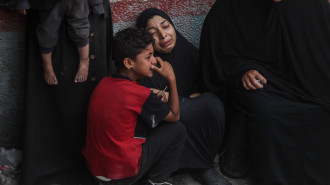
Israel's war on Gaza's economy a year on: Killing by other means

In northern Rafah lies the remnants of a once-thriving farmland, now reduced to rubble after being razed by Israeli forces.
Palestinian farmer Yaqoub Abu Daabs, 55, surveys the devastation of his farm, unable to approach the land to assess the full extent of the damage or retrieve any agricultural tools and supplies partially buried beneath the destruction.
After losing his son Muath, 27, who was killed by an Israeli airstrike three months ago while trying to reach the farmland, Abu Daabs now refuses to risk venturing near the area again.
“Muath had hoped to salvage whatever remained before bulldozers and tanks finished the destruction,” he told The New Arab.
“After his death, they set fire to storage facilities and demolished two vital water wells.”
Besides the death of his son, the farmer is grappling with the loss of two full harvest seasons since the war erupted, a blow that devastated his livelihood.
Without access to irrigation, his crop yields were cut in half. As harvest approached, Israeli airstrikes made it too dangerous for him to reach his land.
After years of hard work to restore the soil's fertility, the land was entirely obliterated.
Abu Daabs has been leasing 70 dunams (around 17 acres) from the Palestinian Land Authority for several years. He invested heavily in levelling the land, digging water wells, installing irrigation networks, and securing the necessary agricultural infrastructure, hoping to recoup his costs over time.
“Everything is wiped out now and I turned from a productive farmer contributing to the national economy to an indebted man,” he expressed.
Abu Daabs believes that the war directly impoverished him, decimating an economic operation that had provided a year-round livelihood for around 40 families in addition to dozens more on a part-time basis.
“I used to be financially well-off before the war, but now I’m one of the vast majority in Gaza who is in need after losing more than half a million dollars in damaged infrastructure and crops.”
Along with many other farmers who lost their land, Abu Daabs suffers. He said, “Most of us have been reduced to beggars, relying on humanitarian aid to survive. It’s a full-blown economic catastrophe in every sense.”
The agricultural sector, according to him, has endured near-total destruction in countless ways, the simplest being bombings and bulldozing.
He warns that the few remaining farmers risk halting their activities entirely due to a shortage of agricultural inputs.
One year after the war, Israeli authorities continued to block the entry of essential supplies, and the farmland itself was destroyed.
Seeds, fertilizers, irrigation systems, and other production necessities have all run out.
“After the current agricultural season, there will be no local vegetables available for people to eat,” he said.
Abu Daabs' losses are emblematic of the broader devastation that has crippled Gaza’s economic sectors, including industry, production, commerce, and tourism.
Once the backbone of Gaza's economy, which has been under siege since 2007, these sectors have been nearly wiped out by the war.
According to a report by the United Nations Conference on Trade and Development (UNCTAD), between 80 and 96 percent of Gaza’s agricultural assets have been damaged, leading to a near-total collapse in food production and exacerbating already high levels of food insecurity.
The report, released in early September, also noted that 82 percent of businesses, which had been vital to the economy, were destroyed, and two-thirds of jobs that existed before the war was lost.
By mid-2024, Gaza's economy had contracted to one-sixth of its 2022 level.
Down Salah al-Din Street, the main artery running through central Gaza, factories, warehouses, shops, and service facilities all lie in ruins.
The same fate has befallen three major industrial zones in Gaza, including one located east of Beit Hanoun in the northern region, another situated east of Gaza City, and a third positioned east of Deir al-Balah in central Gaza.
Muhammad al-Namrouti, 60, describes his life as that of the “living dead.” Still displaced beside the ruins of his home, unable to provide for his family of seven, his story reflects the plight of many others.
Like Abu Daabs and many Palestinians in Gaza, al-Namrouti has lost all his savings, which he had set aside for emergencies. After a year of relentless war, soaring prices, and a complete halt in work and production, they now rely on humanitarian aid to meet their families' basic needs.
According to Mohammed Alamour, the Palestinian economy minister, the government is working on providing relief to Gaza, focusing on health, social development, humanitarian aid, water, and energy.
“We’re surviving solely on aid,” al-Namrouti added. “I can’t afford a single vegetable or any basic food item, not because of the sky-high prices, but because I have no money at all.”
He now lives in one of southern Gaza's displacement camps, where families struggle to survive without basic necessities like food and clothing.
According to al-Namrouti, all his relatives, neighbours, and friends have been living in similar “dire conditions” since the war obliterated their sources of income.
the relentless Israeli attacks [Getty]
According to the World Bank, the Palestinian territories are nearing “freefall” into economic disaster amid a historic humanitarian crisis, with Gaza’s economy on the verge of total collapse after shrinking by a staggering 86 percent in the first quarter of 2024.
As of September, prices of basic goods increased 250 percent and food insecurity has driven around two million people to the edge of a widespread famine, a World Bank Report revealed.
“There is no real economy in Gaza anymore, not in the conventional sense,” Mohammad Abu Jayyab, editor-in-chief of the Economic Journal, told The New Arab. “The economic cycle is frozen, and the infrastructure is run by local families and communities.”
The war has incapacitated Gaza’s financial system as well as its industrial, agricultural, commercial, technological, and communication sectors.
According to Abu Jayyab, 90 percent of the industrial sector, which once employed 27,000 workers, has been destroyed.
“Additionally, 90 percent of the tourism sector, which used to employ 10,000 workers, is gone,” he noted, adding that the commercial sector and most of the agricultural sector, which previously provided jobs for 70,000 workers, have also been severely impacted.
Gaza's service sector, banking institutions, and telecommunications infrastructure have suffered “massive losses,” with major companies facing crippling damages, according to Abu Jayyab.
The editor warns that Gaza’s economic recovery depends entirely on ending the war, reopening border crossings, and allowing the import of raw materials and production lines.
Minister Alamour agrees with Abu Jayyab and warns that no economic revival is possible as long as the assault and what he called the “genocide” by the Israeli government continues.
“Current international efforts are limited and lack strategic depth,” he said, highlighting that they focus on small-scale individual initiatives and do not provide a comprehensive solution to restoring economic life.
Simple efforts to support small, self-initiated projects would not succeed in reviving the economic cycle, according to Abu Jayyab. With no production in any sector, food security is severely impacted.
With unemployment in Gaza exceeding 90 percent, he stresses that $4 billion in aid is needed to restore the economic cycle.
While the Palestinian government has completed a comprehensive plan for the reconstruction of Gaza and economic recovery, ready to be implemented the day after the Israeli aggression ends, according to Alamour, there’s a need for “the aggression to stop for the government to execute its plans.”
That is a sentiment that Abu Jayyab agrees with, saying, “The reality on the ground shows that Gaza's economy is incapable of functioning under current war conditions.”
Mohamed Solaimane is a Gaza-based journalist with bylines in regional and international outlets, focusing on humanitarian and environmental issues
This piece is published in collaboration with Egab






 Follow the Middle East's top stories in English at The New Arab on Google News
Follow the Middle East's top stories in English at The New Arab on Google News


